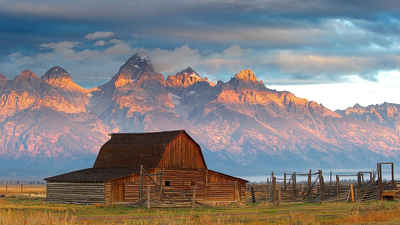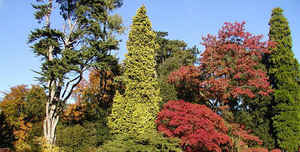Wyoming State Tree
Plains Cottonwood

(Populus deltoids occidentalis)
Adopted on February 1, 1947 - Amended: 1961.
The Plains Cottonwood, (Populus deltoids occidentalis,) was adopted as Wyoming state tree on February 1, 1947.
The plains cottonwood is a large, fast-growing, short-lived tree of the Great Plains and eastern border of the Rocky Mountains. Members of the willow family, cottonwoods are named for the cottonlike mass of hairs surrounding their seeds. They are related to poplars and aspens.
Wyoming State Tree: Plains Cottonwood

Populus is the Latin name for poplars. Deltoides refers to the triangular-shaped leaves. Occidentalis is Latin for "west." American Indians may not have distinguished the two since different names have not been identified. The Lakota know them as canyß¡h'u, meaning "peel off wood," and the Omaha as maa-zho.
Cottonwoods are members of Salicaceae, the willow family, along with willow (Salix spp.) and quaking aspen (Populus tremuloides ). The leaves are deciduous, alternate, simple, 3 to 6 inches (8 to 15 cm) long, triangular-shaped with serrate margins. Flowers occur in the spring before the leaves appear, they are dioecious and in hanging catkins . Fruits are 1/4 inch (.64 cm) long, 3 or 4 valved capsules. The twigs are yellowish brown and smooth. The terminal buds are long and resinous. The bark is ash-gray and divided in thick flattened ridges with deep furrows.

Plains cottonwood is native throughout the central plains from Texas to Manitoba. Cottonwood, as with willow, is a pioneer species. It is also very intolerant of competition. Cottonwoods tend to seed into a new flood plain and develop as pure, even-aged stands. As cottonwoods mature (about 50-70 years after the stand begins), they are gradually replaced by the more tolerant ash and elm.
The two greatest threats to cottonwood are fire and drought. Cottonwoods are very vulnerable to fire, light burns will kill seedlings and saplings. Hotter fires can severely injure the bark on older trees, which opens the trees up to decay. While they are moderately drought tolerant, a long-term dry spell will lead to death.
Identification of the Plains Cottonwood

- Life Span: Cottonwood is not a very long-lived tree. As with their close relative, willow, cottonwoods usually live about 70 years. A 120 year old cottonwood is a very old tree.
- Size: While cottonwoods may not live very long, they are very fast growing so big trees are a common sight. The largest cottonwood is in Grundy County, Illinois. It is 373 inches (947 cm) in circumference, 132 feet (40 m) tall with a branch spread of 99 feet (30 m). The largest in South Dakota is a plains cottonwood near Richland in Union County. It is 344 inches (873 cm) in circumference, 114 feet (35 m) tall with branch spread of 113 feet (34 m).
- Significance: Wood of the cottonwood is light. It was important as a construction material for the American Indians and European settlers. Cottonwood, because of its abundance, was used to build barns and houses. Occasionally large cottonwoods, 4 to 6 feet (123 to 183 cm) in diameter, were cut down and burned out to form a crude canoe. Today cottonwood is used for pulp and sometimes lightweight furniture. Cottonwood is also used as a windbreak species although it is not highly recommended due to its short life expectancy.
The Dakota ate the sweet inner bark of young sprouts of cottonwood trees in the spring. They also fed young cottonwood branches to their horses. A dye was made from the leaf buds. The Sacred Pole, used in ceremonies of the Omaha Indians, is made of cottonwood.
Wyoming Law
The law designating the cottonwood tree as the official Wyoming state tree is found in the Wyoming Statutes, Title 8, Chapter 3, Section 8-3-106.
TITLE 8 - GENERAL PROVISIONS
CHAPTER 3 - STATE SEAL, FLAG, FLOWER, BIRD AND OTHER SYMBOLS
8-3-106. State tree.
Universal Citation: WY Stat § 8-3-106 (2013)
8-3-106. State tree.
The Populus Sargentii commonly called cottonwood tree, is the state tree of Wyoming.
Taxonomic Hierarchy: Plain Cottonwood
Kingdom: Plantae - Plants
Subkingdom: Tracheobionta - Vascular plants
Superdivision: Spermatophyta - Seed plants
Division: Magnoliophyta - Flowering plants
Class: Magnoliopsida - Dicotyledons
Subclass: Dilleniidae
Order: Salicales
Family: Salicaceae - Willow family
Genus: Populus L. - cottonwood
Species: Populus deltoides W. Bartram ex Marshall - eastern cottonwood
Subspecies: Populus deltoides Bartr. ex Marsh. ssp. monilifera (Ait.) Eckenwalder --plains cottonwood








